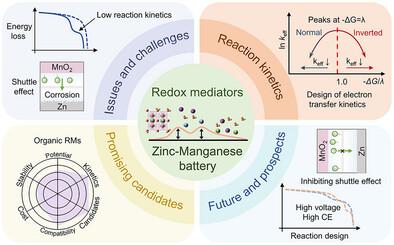水电解锌锰电池的氧化还原介质:基本原理和设计标准
IF 26
1区 材料科学
Q1 CHEMISTRY, PHYSICAL
引用次数: 0
摘要
虽然水电解质锌锰电池(azmb)由于其较高的理论能量密度而引起了广泛的关注,但其实际应用一直受到阴极Mn2+/MnO2转化反应可逆性不足的阻碍。引入氧化还原介质(RMs)作为电子转移催化剂,使电化学惰性的“死MnO2”在放电过程中转化为活性的Mn2+离子,有效地增强了阴极可逆性。然而,由于对RM的基本性质及其与MnO2的反应动力学之间的关系了解有限,RM辅助AZMB体系的实际应用受到严重阻碍。应用经典Marcus理论,阐明了RM的基本结构与其反应动力学之间的关系,为RM辅助MnO2电还原过程的热力学行为和动力学行为之间的冲突提供了连贯的解释。重点是建立理论基础和设计范例,包括有机RM分子的设计,高效基于RM的反应体系的构建,以及无穿梭方法的制定,从而设计和推进高性能RM辅助azmb。本文章由计算机程序翻译,如有差异,请以英文原文为准。

Redox Mediators for Aqueous Electrolytic Zinc‐Manganese Batteries: Fundamentals and Design Criteria
Although aqueous electrolytic zinc‐manganese batteries (AZMBs) have attracted significant attention due to their high theoretical energy density, their practical application has been hindered by the insufficient reversibility of the cathodic Mn2+ /MnO2 conversion reaction. Introducing redox mediators (RMs) as electron transfer catalysts enables the conversion of electrochemically inert “dead MnO2 ” into active Mn2+ ions during discharging, effectively enhancing cathodic reversibility. However, the practical application of RM‐assisted AZMB systems is severely hindered by a limited understanding of the relationship between the fundamental properties of RMs and their reaction kinetics with MnO2 . By applying classical Marcus theory, the correlation between the fundamental structures of RMs and their reaction kinetics is elucidated, offering a coherent explanation for the conflict between the thermodynamic and kinetic behaviors of the RM‐assisted MnO2 electroreduction process. Emphases are placed on establishing a theoretical foundation and design paradigms, including the design of organic RM molecules, construction of efficient RM‐based reaction systems, and formulation of shuttle‐free approaches, thereby designing and advancing high‐performance RM‐assisted AZMBs.
求助全文
通过发布文献求助,成功后即可免费获取论文全文。
去求助
来源期刊

Advanced Energy Materials
CHEMISTRY, PHYSICAL-ENERGY & FUELS
CiteScore
41.90
自引率
4.00%
发文量
889
审稿时长
1.4 months
期刊介绍:
Established in 2011, Advanced Energy Materials is an international, interdisciplinary, English-language journal that focuses on materials used in energy harvesting, conversion, and storage. It is regarded as a top-quality journal alongside Advanced Materials, Advanced Functional Materials, and Small.
With a 2022 Impact Factor of 27.8, Advanced Energy Materials is considered a prime source for the best energy-related research. The journal covers a wide range of topics in energy-related research, including organic and inorganic photovoltaics, batteries and supercapacitors, fuel cells, hydrogen generation and storage, thermoelectrics, water splitting and photocatalysis, solar fuels and thermosolar power, magnetocalorics, and piezoelectronics.
The readership of Advanced Energy Materials includes materials scientists, chemists, physicists, and engineers in both academia and industry. The journal is indexed in various databases and collections, such as Advanced Technologies & Aerospace Database, FIZ Karlsruhe, INSPEC (IET), Science Citation Index Expanded, Technology Collection, and Web of Science, among others.
 求助内容:
求助内容: 应助结果提醒方式:
应助结果提醒方式:


